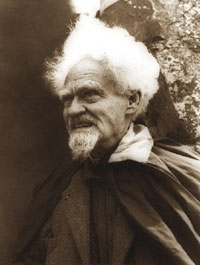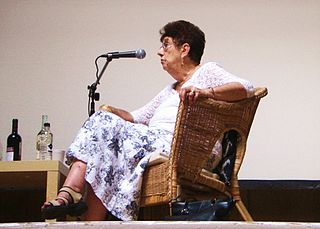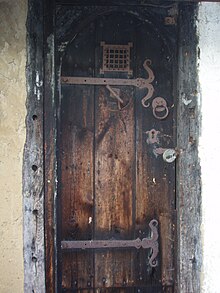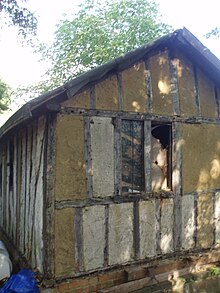
Gardnerian Wicca, or Gardnerian witchcraft, is a tradition in the neopagan religion of Wicca, whose members can trace initiatory descent from Gerald Gardner. The tradition is itself named after Gardner (1884–1964), a British civil servant and amateur scholar of magic. The term "Gardnerian" was probably coined by the founder of Cochranian Witchcraft, Robert Cochrane in the 1950s or 60s, who himself left that tradition to found his own.

Gerald Brosseau Gardner, also known by the craft name Scire, was an English Wiccan, as well as an author and an amateur anthropologist and archaeologist. He was instrumental in bringing the Contemporary Pagan religion of Wicca to public attention, writing some of its definitive religious texts and founding the tradition of Gardnerian Wicca.

Wicca, also known as The Craft, is a modern neo-pagan syncretic religion. Scholars of religion categorize it as both a new religious movement and as part of occultist Western esotericism. It was developed in England during the first half of the 20th century and was introduced to the public in 1954 by Gerald Gardner, a retired British civil servant. Wicca draws upon a diverse set of ancient pagan and 20th-century hermetic motifs for its theological structure and ritual practices.

A Book of Shadows is a book containing religious text and instructions for magical rituals found within the Neopagan religion of Wicca. Since its conception in the 1970s, it has made its way into many pagan practices and paths. The most famous Book of Shadows was created by the pioneering Wiccan Gerald Gardner sometime in the late 1940s or early 1950s, and which he utilised first in his Bricket Wood coven and then in other covens which he founded in following decades. The Book of Shadows is also used by other Wiccan traditions, such as Alexandrian Wicca and Mohsianism, and with the rise of books teaching people how to begin following non-initiatory Wicca in the 1970s onward, the idea of the Book of Shadows was then further propagated amongst solitary practitioners unconnected to earlier, initiatory traditions.

Doreen Edith Dominy Valiente was an English Wiccan who was responsible for writing much of the early religious liturgy within the tradition of Gardnerian Wicca. An author and poet, she also published five books dealing with Wicca and related esoteric subjects.

Lois Bourne who also went under the craft name Tanith, was an influential figure in the Neopagan religion of Wicca, having been involved in it from the early 1960s, and wrote a number of books on the subject. Originally initiated into Gardnerian Wicca by Gerald Gardner, she rose to become the high priestess of the Bricket Wood coven, the first Wiccan coven started by Gerald Gardner, which was based in Bricket Wood in Hertfordshire, working alongside the high priest Jack Bracelin.

Edith Rose Woodford-Grimes (1887–1975) was an English Wiccan who achieved recognition as one of the faith's earliest known adherents. She had been a member of the New Forest coven which met during the late 1930s and early 1940s, and through this became a friend and working partner of Gerald Gardner, who would go on to found the Gardnerian tradition with her help. Widely known under the nickname of Dafo, Woodford-Grimes' involvement in the Craft had largely been kept a secret until it was revealed in the late 1990s, and her role in the history of Wicca was subsequently investigated by historians.
The Wiccan Laws, also called the Craft Laws, the Old Laws, the Ardanes or simply The Laws are, according to claims made by Gerald Gardner in the 1950s, ancient laws governing the practice of Covens, passed from initiate to initiate as part of the Book of Shadows.

The New Forest coven were an alleged group of pagan witches who met around the area of the New Forest in southern England during the early 20th century. According to his own claims, in September 1939, a British occultist named Gerald Gardner was initiated into the coven and subsequently used its beliefs and practices as a basis from which he formed the tradition of Gardnerian Wicca. Gardner described some of his experiences with the coven in his published books Witchcraft Today (1954) and The Meaning of Witchcraft (1959) although on the whole revealed little about it, saying he was respecting the privacy of its members. Meanwhile, another occultist, Louis Wilkinson, corroborated Gardner's claims by revealing in an interview with the writer Francis X. King that he too had encountered the coven and expanded on some of the information that Gardner had provided about them. According to Gardner, the faith they followed was the Witch-Cult, a supposed pagan religion that had survived in secret after the Christianization of Europe. This was in keeping with the now-discredited theories of Margaret Murray and her supporters.

A craft name, also referred to as a magical name, is a secondary religious name often adopted by practitioners of Wicca and other forms of Neopagan witchcraft or magic. Craft names may be adopted as a means of protecting one's privacy, as an expression of religious devotion, or as a part of an initiation ritual. It may also be used as a protective method, as it is believed by some that one's "true name" can be used to identify that person for the purpose of magical activities.

Philip Heselton is a retired British conservation officer, a Wiccan initiate, and a writer on the subjects of Wicca, Paganism, and Earth mysteries. He is best known for two books, Wiccan Roots: Gerald Gardner and the Modern Witchcraft Revival and Gerald Gardner and the Cauldron of Inspiration, which gather historical evidence surrounding the New Forest coven and the origins of Gardnerian Wicca.
Eleanor "Ray" Bone who also went under the craft name Artemis, was an influential figure in the neopagan religion of Wicca. She claimed to have been initiated in 1941 by a couple of hereditary witches in Cumbria. She later met and became friends with Gerald Gardner, and was initiated into Wicca, becoming the High Priestess in one of his covens. She was a friend of several important figures in Wicca during the modern Witchcraft revival, including "Dafo", Jack Bracelin, Patricia Crowther, Doreen Valiente and Idries Shah. Bone was a close confidant of Gardner's initiator Dafo, and she reported that the New Forest coven was a hereditary coven that followed the old ways of the Hampshire region, and that they traced their origins to the time of the death of King William Rufus in the Norman era.
Frederic Lamond was a prominent English Wiccan. He was an early member of the Gardnerian tradition having been initiated into the Bricket Wood coven in 1957. He became involved in a number of Pagan organisations, including the Fellowship of Isis, and participated in the interfaith movement. He wrote a number of books on the subject of Wiccan theology and history.
The history of Wicca documents the rise of the Neopagan religion of Wicca and related witchcraft-based Neopagan religions. Wicca originated in the early 20th century, when it developed amongst secretive covens in England who were basing their religious beliefs and practices upon what they read of the historical witch-cult in the works of such writers as Margaret Murray. It also is based on the beliefs from the magic that Gerald Gardner saw when he was in India. It was subsequently founded in the 1950s by Gardner, who claimed to have been initiated into the Craft – as Wicca is often known – by the New Forest coven in 1939. Gardner's form of Wicca, the Gardnerian tradition, was spread by both him and his followers like the High Priestesses Doreen Valiente, Patricia Crowther and Eleanor Bone into other parts of the British Isles, and also into other, predominantly English-speaking, countries across the world. In the 1960s, new figures arose in Britain who popularized their own forms of the religion, including Robert Cochrane, Sybil Leek and Alex Sanders, and organizations began to be formed to propagate it, such as the Witchcraft Research Association. It was during this decade that the faith was transported to the United States, where it was further adapted into new traditions such as Feri, 1734 and Dianic Wicca in the ensuing decades, and where organizations such as the Covenant of the Goddess were formed.

In the neopagan religion of Wicca a range of magical tools are used in ritual practice. Each of these tools has different uses and associations and are commonly used at an altar, inside a magic circle.

Neopagan witchcraft, sometimes referred to as The Craft, is an umbrella term for some neo-pagan traditions that include the practice of magic. These traditions began in the mid-20th century and were influenced by the witch-cult hypothesis, a now-rejected theory that persecuted witches in Europe had actually been followers of a surviving pagan religion. Traditions classed as neopagan witchcraft include Wicca and the various movements that describe themselves as "Traditional Witchcraft".
Jack Leon Bracelin was an English high priest of Gardnerian Wicca. He was an influential figure in the early history of Neopagan religion, having been initiated into the craft by Doreen Valiente in 1956. He was a member of the Bricket Wood coven.

Raymond Howard was an English practitioner of the modern Pagan new religious movement of Wicca. He promoted his tradition, known as the Coven of Atho, through a correspondence course established in the early part of the 1960s.
The Witchcraft Research Association was a British organisation formed in 1964 in an attempt to unite and study the various claims that had emerged of surviving remnants of the so-called Witch-Cult, such as those of Gerald Gardner, Robert Cochrane, Sybil Leek, Charles Cardell and Raymond Howard.
In Modern English, the term Wicca refers to Wicca, the religion of contemporary Pagan witchcraft. It is used within the Pagan community under competing definitions. One refers to the entirety of the Pagan Witchcraft movement, while the other refers explicitly to traditions included in what is now called British Traditional Wicca.
















